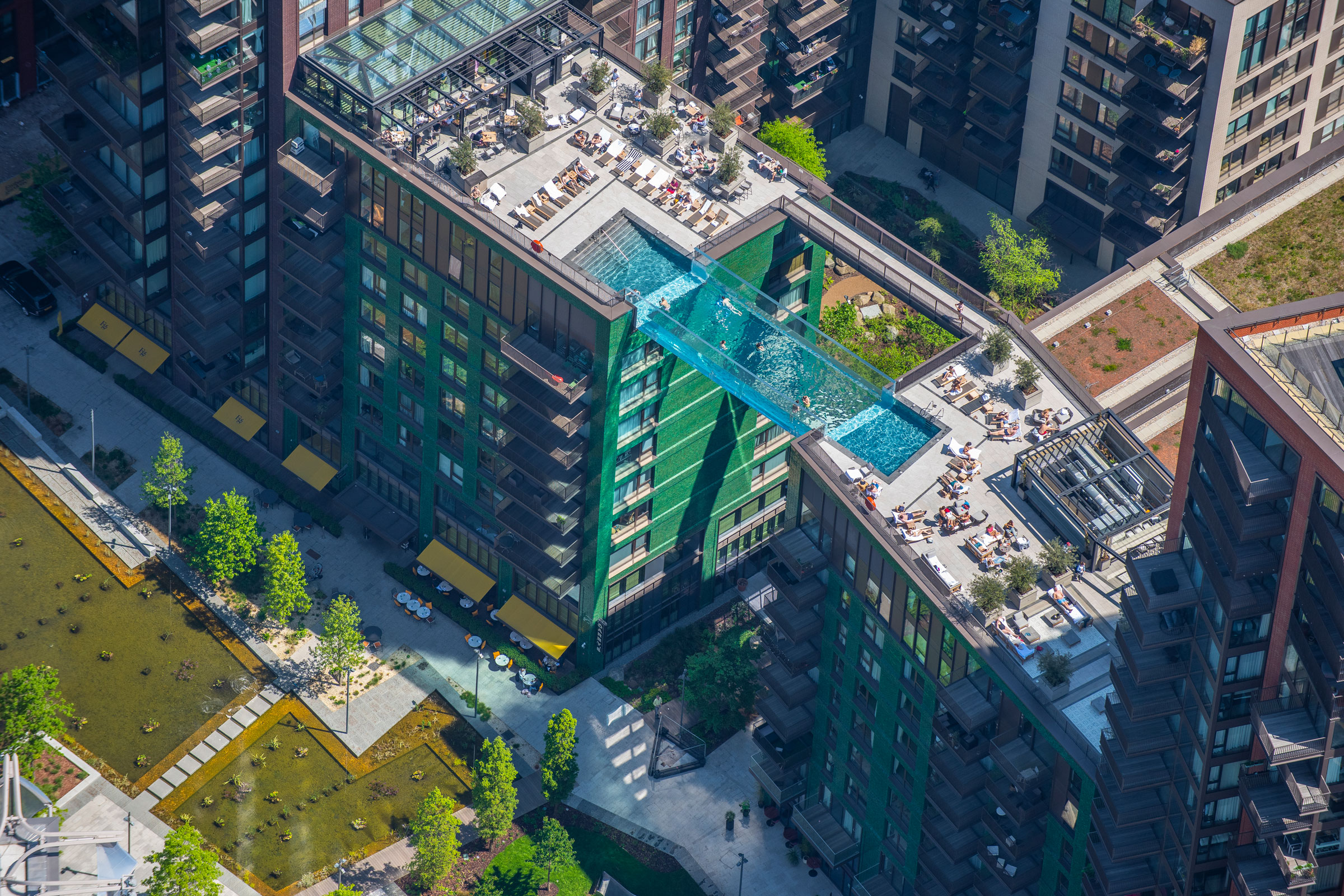Story at a glance:
- Stainless steel offers architects and designers the flexibility to create bold, custom aquatic designs.
- Luxury features like acrylic viewing windows, rain curtains, and automated lighting systems are growing in popularity.
- Bradford Products, a pioneer in stainless steel aquatics, has produced daring designs in projects around the world.
The market for high-end aquatic experiences has seen a surge of creativity and innovation, with pool and spa designs that literally float in the air hundreds of feet off the ground. Custom features like synchronized, mobile-controlled lighting, water, and sound systems are becoming more and more common.
But to facilitate these remarkable designs, architects and developers are turning to aquatic vessels built not in traditional concrete or fiberglass, but rather stainless steel. The material is light but highly durable, versatile, and can be precision engineered to a degree that competing materials cannot.
“There is not much that can’t be achieved with a stainless steel pool,” says Greg Mash, creative director at Bradford Products, a specialized manufacturer of stainless steel aquatic vessels.
Bradford Products has been a driving force behind the growing use of stainless steel in pools and spas. The third-generation, family-run firm pioneered the commercialization of stainless steel hot tubs in the 1980s and today is a market leader with projects around the globe.
Whether a client is aiming for a more traditional design with mosaic tiles and grand entryways or wants to create a minimalist motif with clean lines and modern touches, stainless steel offers architects the flexibility needed to incorporate complex design specifications.
“Because of the high engineering requirements that can be achieved with stainless steel, this opens the door for creativity and personalization,” Mash says. “Good design should be integral to every aspect of the project.”
Best Use Cases
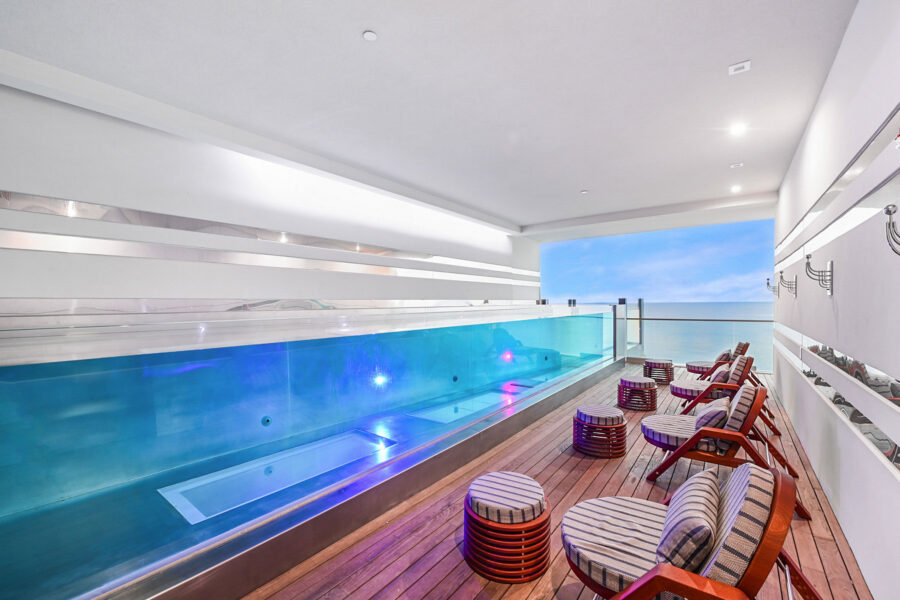
This acrylic pool is at home in high-end hospitality. Photo courtesy of Bradford Products
Stainless steel is a smart material choice for designing pools and spas in any use case—whether it be in single-family or high-rise residential, hotels, or recreational facilities like sports complexes and wellness centers.
Its lightweight strength and ability to be transported and installed in tight quarters makes it the top choice for specialized projects. “High structural integrity and water-tight requirements, as well as complex engineering projects, typically drive the use of stainless steel for aquatic vessels,” Mash says.
These include design scenarios where a pool is cantilevered over the side of a building or installed on top of an existing high-rise that wasn’t designed to support the weight of additional concrete. And any time customers want custom additions like acrylic viewing windows, the adaptability of stainless steel makes it the ideal vessel material choice.
Particular onsite conditions like restricted site access or limited local labor pools also necessitate the use of stainless steel. Around the world many new high-end resorts are being constructed in remote locations where concrete can be problematic to source and transport, or there may be a dearth of skilled trades workers for installation.
Retrofits of historic buildings, which often require stringent water-tight requirements and exact tolerances, are also becoming increasingly popular. At the Aman Hotel in Manhattan’s historic Crown Building, Bradford manufactured 15 vessels designed by outside architects—including the seventh floor commercial pool.
“Being an elevated pool, installed over finished floors below, stainless steel construction was vital for this pool and all the other vessels to ensure water-tight integrity,” Mash says. The modular nature of Bradford’s manufacturing and installation process made it easier to respect the historic nature of the building.
“The variety of ways a stainless steel vessel can be delivered, in sections or fully fabricated, saves time, money, and onsite specialty services,” Mash says.
Design Trends
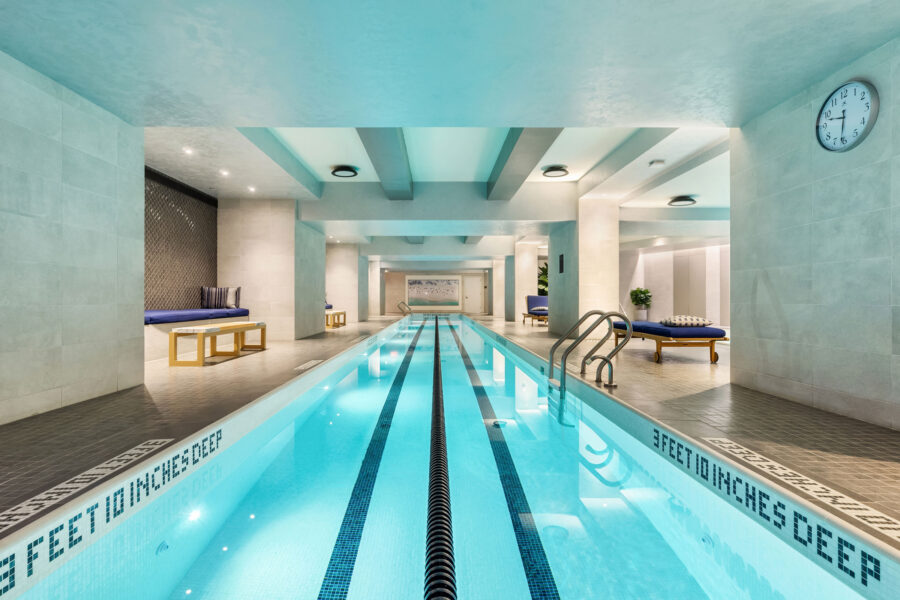
Photo courtesy of Bradford Products
In the aquatics market today customer demand is gravitating toward a sleek modernism stainless steel is uniquely suited for.
“We’re seeing a return to simple, clean, and unobstructed forms, both for the internal elements and features to the overall shape of the pool or spa,” Mash says. “Grandiose entry steps that run the full width of the pool, large, oversized Baja decks, and jetted seating areas in the pools for added hydrotherapy experiences are also increasingly popular.”
For the higher end market, automated lighting and water features as well as personalized touches are becoming the norm. In the residential space lounge chairs are being designed down to the height of the user. For commercial clients Mash says Bradford has been adding more spa-like features like immersion zones and champagne bubbler loungers.
We’re seeing a return to simple, clean, and unobstructed forms.
Architects and developers are also getting more daring with the placement of aquatic vessels, thanks in large part to the fact that stainless steel is lighter, stronger, and more versatile than concrete. The Skypool at Embassy Gardens in London, which features an 82-foot acrylic “floating pool” suspended 115 feet in the air, is perhaps the most striking example, but the race to design the next eye-popping aquatic experience is never ending.
At the same time, traditional features and trends like negative edges, large viewing windows, and oversized waterfalls and rain curtains “continue in popularity and don’t seem to be waning anytime soon,” Mash says. “People love the sights and sounds of moving water. The added wow factor they deliver seems fully entrenched in the design process moving forward.”
Design Capabilities
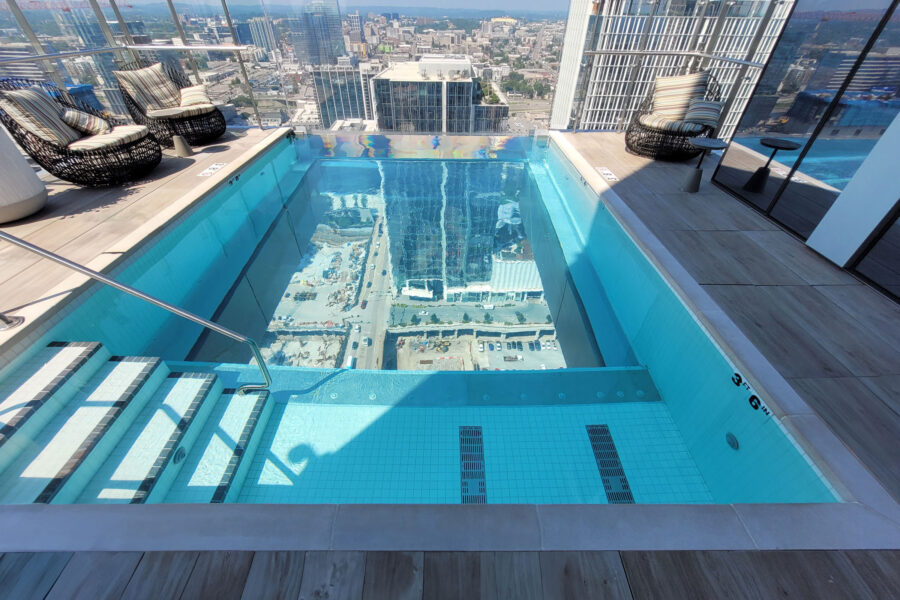
Photo courtesy of Bradford Products
The versatile properties of stainless steel and the ability to precision engineer shapes and lines down to one-one thousandths of an inch gives architects and designers far more creative leeway than materials like concrete or fiberglass. From traditional and elegant to ultra-modern, stainless steel brings a sophistication to any type of aquatic design.
“Due to the hand-built fabrication of a stainless steel vessel, all manner of custom elements are easily incorporated in the design of our pools and spas,” Mash says. His team works hand-in-hand with outside architects and designers to bring the customer’s vision to reality.
Today’s customers—both residential and commercial—are looking to create that wow factor with their aquatic features, Mash says, and elevated pools offer some of the best opportunities to showcase dramatic concepts.
For example, every condo in The Honeycomb, an eight-story luxury residential building in the Bahamas, features a personal swimming pool with a balcony-length acrylic viewing wall. Bradford was commissioned to build 34 unique vessels that were elegantly designed to vanish into the building’s facade. Custom bench seating and soothing hydrotherapy jets were added for a luxury bathing experience, and interior aquatic lighting complements the building’s striking architectural style.
And while the material helps facilitate bold design choices, “stainless steel itself is inherently attractive and visually interesting in its own right,” Mash says. “Stainless steel is unique in the sense that it has its own mood.”
Its ever-changing personality reflects the weather and surrounding environment; on sunny days stainless steel sparkles in the light, while overcast skies or local foliage are refracted to create cooler moods.
“It’s unlike a lot of other materials,” Mash says. “It’s almost like aquatic jewelry.”
Endless Add-Ons and Features
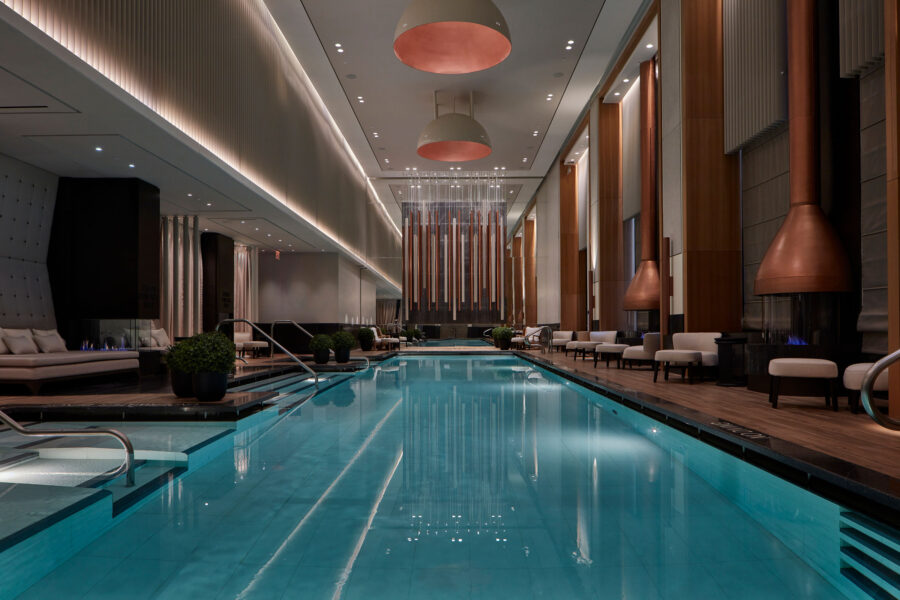
Aman NYC. Photo courtesy of Bradford Products
Technological innovation in the aquatics market is driving the popularity of custom designs that include fully automated lighting systems and water features. The ability to tie aquatic lighting to audio systems and DJ booths creates an impressive pre-programmed sensory experience.
These high-end features were once seen only in large luxury resorts, but the advances in the tech that power them mean “there’s a lot of crazy automation going on at the residential level” today, too, Mash says. Third-party mobile apps allow customers to conveniently and remotely control lighting and water features, providing a resort-like experience.
And while stainless steel is visually stunning on its own, customers can also incorporate luxury material like ceramic and glass mosaic tile, stone veneers, large format stone coping, and edge work that “take the completed installation to another level of sophistication,” Mash says.
Tiling stainless steel can be a challenge if not done properly. Bradford has developed a proprietary two-part epoxy adhesive that has a certain amount of elasticity so that when the stainless steel expands at one rate, and the tile or other material at another rate, the epoxy serves as a flexible contact between the two materials. “The fluctuation in temperatures requires it, if you want it to last and avoid cracking,” Mash says.
Whether customers are looking to add custom-built recliners, rain curtains, viewing windows, or deep immersion zones, stainless steel remains the top material choice to incorporate these features into their aquatic vessels.
“Most people are very excited to learn that stainless steel is a viable and increasingly popular option for their pool or spa,” Mash says.

